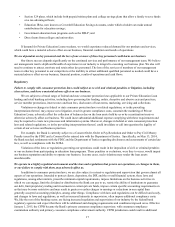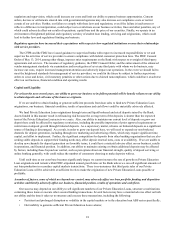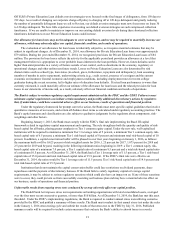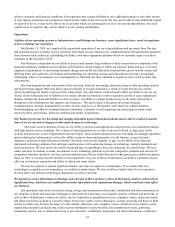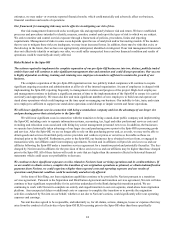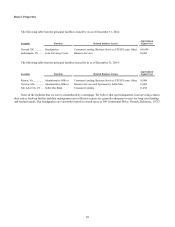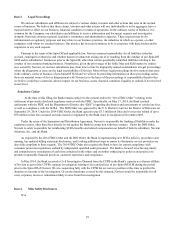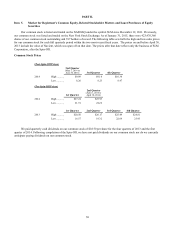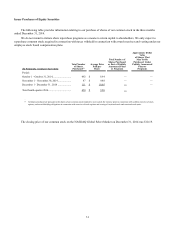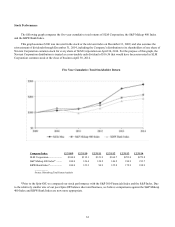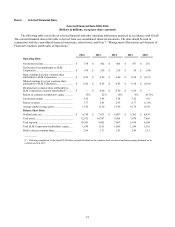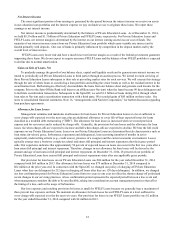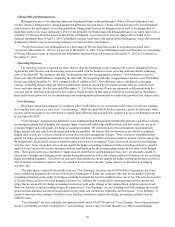Sallie Mae 2014 Annual Report Download - page 28
Download and view the complete annual report
Please find page 28 of the 2014 Sallie Mae annual report below. You can navigate through the pages in the report by either clicking on the pages listed below, or by using the keyword search tool below to find specific information within the annual report.• Our policy of paying no common stock dividends;
• The operating and stock price performance of comparable companies;
• news reports relating to trends, concerns and other issues in the financial services industry, including regulatory actions
against other financial institutions;
• perceptions in the marketplace regarding us and/or our competitors;
• new technology used, or services offered, by competitors;
• significant acquisitions or business combinations, strategic partnerships, joint ventures or capital commitments by or
involving us or our competitors;
• Changes to the regulatory and legal environment under which we and our subsidiaries operate; and
• Domestic and worldwide economic conditions.
The market price of shares of our preferred stock may fluctuate significantly due to a number of factors, some of which
may be beyond our control, including:
• Significant sales of our preferred stock, or the expectation of these sales or expectations of same;
• Lack of credit agency ratings or FDIC insurance;
• Movements in interest rates and spreads that negatively affect return; and
• Call and redemption features.
In addition, when the market price of a company’s common stock drops significantly, stockholders often institute
securities class action lawsuits against the company. A securities class action lawsuit against the Company could cause it to
incur substantial costs and could divert the time and attention of its management and other resources, which could materially
adversely affect our business, financing condition and results of operations.
An investment in our securities is not an insured deposit.
Our common stock, preferred stock and indebtedness are not bank deposits and, therefore, are not insured against loss
by the FDIC, any other deposit insurance fund or by any other public or private entity. Investment in our common stock is
inherently risky for the reasons described in this “Risk Factors” section and elsewhere in this report and is subject to the same
market forces that affect the price of securities of any company. As a result, if you acquire our common stock, preferred stock
or indebtedness, you may lose some or all of your investment.
The holders of our preferred stock have rights that are senior to those of our common shareholders.
At December 31, 2014, we had issued and outstanding 3.3 million shares of our 6.97 percent Cumulative Redeemable
Preferred Stock, Series A and 4 million shares of our Floating-Rate Non-Cumulative Preferred Stock, Series B.
Our preferred stock is senior to our shares of common stock in right of payment of dividends and other distributions. We
must be current on dividends payable to holders of preferred stock before any dividends can be paid on our common stock. In
the event of our bankruptcy, dissolution or liquidation, the holders of our preferred stock must be satisfied before any
distributions can be made to our common shareholders.
We do not intend pay dividends on our common stock.
We have not paid dividends on our common stock since the Spin-Off and we do not expect to do so for the foreseeable
future. We are dependent on funds obtained from the Bank to fund our obligations. Regulatory and other legal restrictions may
limit our ability to transfer funds freely, either to or from our subsidiaries. In particular, the Bank is subject to laws and
regulations that authorize regulatory bodies to block or reduce the flow of funds to us, or that prohibit such transfers altogether
in certain circumstances. These laws, regulations and rules may hinder our ability to access funds that we may need to make
payments on our obligations. The FDIC has the authority to prohibit or to limit the payment of dividends by the banking
organizations they supervise, including us and our bank subsidiaries.
Restrictions on Ownership
The ability of a third party to acquire us is limited under applicable U.S. and state banking laws and regulations.
Under the Change in Bank Control Act of 1978, as amended, (“CIBC Act”), the FDIC’ s regulations thereunder, and
similar Utah banking laws, any person, either individually or acting through or in concert with one or more other persons, must
provide notice to, and effectively receive prior approval from, the FDIC and UDFI before acquiring “control” of us. In practice,
26



